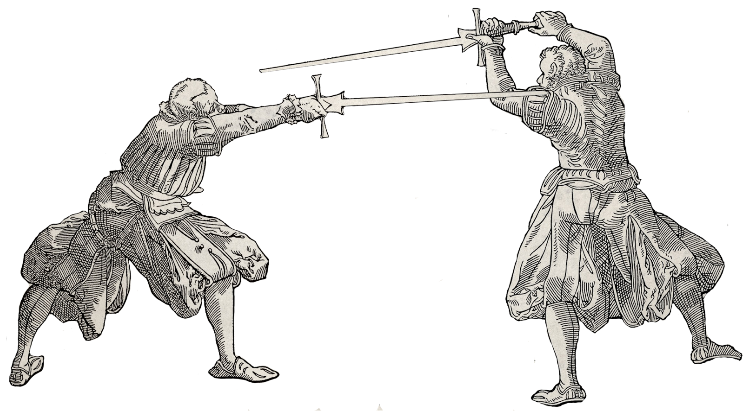Unterhauw
Contents |
Under Strike
Longsword
The unterhauw is a diagonal strike following the same line as the zornhauw, but rising up from below instead of descending.
At a Glance
- Diagonally upward cut, attacking the lower openings.
- Guard transitions: Nebenhut – Einhorn
- Advantages: Allows cuts under the arms of an attacker, can be used as a rising parry for all cuts to the upper openings.
- Disadvantages: Tends to be slightly slower and shorter reaching than cuts from above.
Execution
The canonical unterhauw is performed as follows.
- Begin in nebenhut, the blade beside you, true edge facing forward.
- Begin to bring the sword forward and up along the diagonal line.
- When the blade has passed the hip line passing step through, cutting upward and landing the step as the point passes the opponent’s eye line.
- Continue the movement through to einhorn.
Considerations
The unterhauw has slightly less reach than the strikes from above because of an effect known as “shortening” of the sword; this shortening occurs because in a rising strike from below there is a larger angle between the forearm and blade, this reduces the effective reach slightly, as you can see in the figure below:
The figure on the right fights with a “shortened” sword, while the figure on the left fights “long”. The reach discrepancy is only in the order of perhaps a few inches or so, but in a fencing bout this is sufficient to make the difference between a successful strike and a miss.
Notice at the end point you are well protected against any blow from above as the sword shields you as it rises. The unterhau benefits from both horizontal and vertical momentum, as described in the zornhau.
Application
Aside from being a cut the Unterhauw is also useful as a cutting parry from below against any attacks to the high openings. From here we can thrust with the point (Stechen) to threaten the face or slice them, or we might wind back down with an arm cut in the manner of a Windthauw.
Rappier
The low strike with the rappier is carried out in the same way as the longsword cut of the same name, ascending from a low position up through a rising diagonal to an ochs position. While there are variations on this cut used in Meyer's 1570 text he doesn't provide a specific name.

